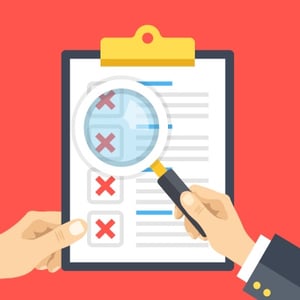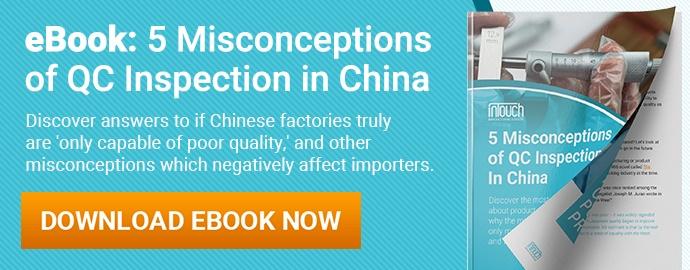 “There was a power outage, so we need to delay inspection.”
“There was a power outage, so we need to delay inspection.”
“A machine is broken, so we haven’t been able to finish the order yet.”
“Our sub-supplier hasn’t delivered the packaging materials yet.”
Sound familiar? You might have heard several different excuses for why a supplier isn’t ready for an inspection.
While third-party inspection has become more common over the last decade, some suppliers still resist it. They might stall during the booking process, for example, refuse to allow inspectors access to goods at their facility or dispute inspection results.
Attempting to enforce your inspection requirements can cause tension when a factory manager is reluctant to cooperate with third-party QC. But the consequences you could face in avoiding potential conflict by forgoing inspection can be much worse.
Here we’ll explore the steps you can take to address your supplier’s concerns and clear up misunderstandings regarding third-party inspection (related: 5 Misconceptions of QC Inspection in China [eBook]).
1. State your intent of product inspection before placing your next order
Inspection requires planning. And a factory manager that doesn’t expect independent oversight of production before shipping will likely handle an order differently than if they expect an outside inspection.
For example, they may need to allocate some workers to help unpack and repack goods during and after a pre-shipment inspection.
One of the most common reasons for outside inspection NOT going smoothly is that buyers haven’t set their expectation for it early enough. This often puts the factory in a difficult position because they may have to unexpectedly shuffle workers or delay orders to accommodate an inspection on short notice.
Most suppliers in Asia understand that third-party inspection is a requirement for many importers. But not all importers are the same. And neither are all factories. Clarifying your intentions to send outside inspectors early will help preserve your relationship with your supplier while avoiding production or shipping delays (related: Why You Can't Assume Chinese Suppliers Always Understand Requirements).
Outline non-negotiable inspection requirements in your purchase order
Sometimes firm insistence that inspection is non-negotiable for your order is necessary for getting past a supplier’s resistance.
Renaud Anjoran, a China-based QC expert and author of the blog QualityInspection.org, suggests: “Tell them it is your company policy, or it is required by a big customer, or an owner of the company got upset and enacted it across the board… Anything that will signal it’s not up for negotiations.”
Similarly, Fredrik Gronkvist of China Importal says he once told a supplier that a particular contract term was mandated by edict of the Swedish king, which the supplier accepted.
Whatever your strategy for taking a hardline on inspection, one of the best ways to make this requirement clear is to include it in your purchase order. This requirement on your PO might read as:
Prior to acceptance of the goods for shipment, the entire order must receive a “PASS” result on the pre-shipment inspection report from an appointed inspection agent. In the case of “FAIL” or “PENDING” results, direct authorization by the Buyer is required for shipment.
Outlining your requirement for inspection in your PO will help you hold your supplier accountable and avoid the possibility of them later claiming they didn’t know you needed inspection.
2. Set expectations with suppliers for orders that fail quality inspection
Most importers must face a failed quality inspection at one point or another when manufacturing abroad. But the period after a failed inspection can be even more difficult to manage with suppliers than the initial inspection.
Once production is finished, factory managers are usually eager to release a shipment so they can receive payment and complete other orders. They may try to avoid addressing any quality defects after production and subsequent re-inspection, steps that may delay shipping.
But as the importer, you likely don’t want your goods leaving the factory without first being assured that they meet your quality standards.
If inspection reveals defective goods in your order, it’s up to you to outline next steps for your supplier to ensure quality issues are resolved before shipping.
Clarify the role of third-party inspectors in approving shipments
Suppliers don’t often take remedial steps on their own to address issues uncovered during inspection. Their reluctance to be proactive isn’t necessarily a resistance to making changes. It can often be that they simply don’t know how to move forward.
They sometimes aren’t aware of what authority a third-party inspector has in approving a shipment, compared to their customer. The result could be that the factory ships an order that passes inspection before their customer has had a chance to review.
To avoid this situation, it’s not enough to explain that you’re working with an inspection agent who will follow your criteria to evaluate the shipment. You also need to clarify that you, not the inspector, will make the final call regarding shipping or holding the goods.
It’s also your responsibility to clarify next steps and outline to your supplier how to address defective goods. After identifying defective products:
- Reiterate your standard or specification to your supplier and explain how the defective products fail to meet your standard
- Discuss any risks of new defects being introduced during rework processes
- Agree on an appropriate course of action for handling the defective goods
- Clarify any re-inspection requirement to verify reworked or replacement goods
It’s generally a bad idea to ask a third-party inspector to work with the factory to find causes and solutions for particular quality issues. Doing so could damage your relationship with the supplier.
A product inspector’s role is typically limited to checking and reporting on quality. They usually aren’t qualified to perform root cause analysis. And they have no real authority over your supplier to make changes at the production level.
Holding suppliers accountable for re-inspection fees
The main reason for supplier resistance to addressing quality defects and re-inspection is usually that it will cost them extra time, effort and money. But agreements made up front with your supplier can help incentivize them to meet quality standards.
For example, importers with strong supplier relationships can often get their suppliers to agree to pay any re-inspection fees.
This kind of agreement often helps hold suppliers accountable to quality standards by creating an incentive for passing inspection the first time. The key is to set this expectation up front because you’ll have less leverage in negotiating after you’ve paid a deposit and production has begun.
After negotiating this requirement to your supplier, you might include it in your PO as follows:
The initial inspection of the order will be paid for by the Buyer. Any re-inspection fees due to a failed first inspection and rush, weekend or holiday booking fees due to a booking cancellation or delay will be charged back to the Supplier by the Buyer.
3. Ask your third-party inspection company to customize inspection reporting
Whether you’re shifting from self-inspection or from one inspection company to another, it might make your supplier more comfortable to use the same reporting format you’ve used in previous inspections. Consistency in inspection methods and reporting can help your supplier develop a pattern for identifying and addressing quality issues.
Product inspection reports can often vary in terms of:
- The number and type of pictures included
- The length and organization of the report
- Terminology used to refer to product defects and inspection results
Using consistent reporting can also help ensure your product is being inspected the same way every time.
Imagine you’re used to calling a certain injection molding defect “excess material”. And your new inspection report lists the same issue as “flash”. These terms are synonymous here. But the change in language could cause confusion when communicating with your supplier about the defect and how to address it.
When switching to third-party inspection, look for an inspection company that is willing to provide customized reporting. Most inspection companies have default reporting templates. But flexible inspection companies should be able to offer some customization at no extra cost.
Your supplier won’t likely ask you outright for a specific report format. But asking your third-party inspector to abide by a consistent format can make the switch to third-party QC easier.
4. Review inspection results and adjust inspection criteria to help your factory improve
Once a third-party inspector sends you their report, it’s a good idea to review the results with your supplier, especially when the result is “fail” or "pending". Reviewing inspection results with your supplier can help your supplier “buy in” to the inspection process.
Openly discussing the result can also help your supplier feel that the inspection is helping them meet your requirements, rather than just policing their work. This can reframe what your supplier might otherwise see as an adversarial relationship between them and your inspection company.
Together, you can clearly identify what went wrong and talk through possible ways to prevent any problems from reoccurring.
In this way, inspection results can help suppliers improve quality. However, these improvements won’t be fully realized and long-lasting unless you adjust your product specifications and inspection criteria to better fit your history with the supplier.
Adjusting inspection criteria based on a production history
Managing product quality should never be a static process that fails to adapt from one order to the next. You might sometimes find that your inspection scope is either too loose or even too strict for certain orders or suppliers.
Always send your supplier a copy of your QC checklist before inspection to limit any confusion about inspection criteria and results. This document should clearly outline how inspectors will be evaluating your products.
Some ways you might consider adjusting inspection criteria for future orders based on the history of production include:
- Changing any product requirements or quality tolerances that are unachievable for your supplier
- Adjusting inspection sample sizes based on production history, such as increasing sample sizes at factories where serious issues are common or decreasing them where quality has consistently met expectations
- Adding any new inspection criteria that were overlooked in previous inspections and making a note for inspectors to pay special attention to repeat issues
 When sending your QC checklist to your supplier and inspectors, be sure to point out any changes you’ve made to the document since the last order. Otherwise, factory workers and inspectors may continue to reference an outdated document. And in turn, you’ll likely continue seeing repeat issues.
When sending your QC checklist to your supplier and inspectors, be sure to point out any changes you’ve made to the document since the last order. Otherwise, factory workers and inspectors may continue to reference an outdated document. And in turn, you’ll likely continue seeing repeat issues.
Your supplier should be a partner in your manufacturing business, not a thorn in your side. Reviewing inspection reports and adjusting inspection criteria can help provide clear direction to your supplier, so they can better meet your requirements.
Conclusion
Many suppliers in Asia are familiar with third-party QC inspection, but they might still have questions or concerns about the process. Not all importers or inspection companies handle inspection in the same manner.
If you handle these initial negotiations well, there’s no reason why a third-party inspection should hurt your supplier relationship. In fact, it can even help improve the relationship in some cases.
Setting clear inspection standards and expectations up front with your suppliers can help you both benefit from better product quality. A quality product makes for a happy consumer and a buyer who’s more likely to continue placing orders.
At the end of the day, if your supplier is still resistant to inspection, you might need to ask yourself why. Are they trying to hide something? A supplier that’s uncooperative with third-party inspection is often a cause for concern.
How do you set clear expectations for third-party inspection with your supplier? Share your experiences in the comment section below!







